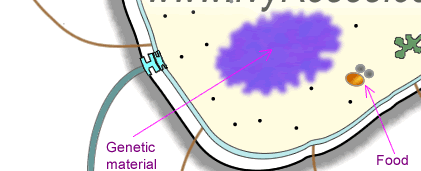Part or Component of Prokaryotic Cell: |
Notes: |
1.  |
Capsule  |
The outer layer of of prokaryotic cells is a gummy or slimy covering (it is sometimes labelled as the "slime capsule") that may help bacteria stay together in colonies and/or provide some protection to the cell. |
2. |
Cell Wall |
Prokaryotic cell walls have a rigid framework of murein, which is a polysaccharide cross-linked by peptide chains. (Compare with plant cell walls which are made mainly of cellulose and animal cells which do not have have cell walls.) |
See further information about prokaryotic cell walls. |
3. |
Plasma membrane |
The plasma membrane (sometimes also called the "cell membrane") is phospholipid bilayer. Note that it is flexible i.e. non-rigid. See also functions of the plasma membrane. |
4. |
Cytoplasm |
Cytoplasm is a gel-like substance that consists mainly of water. In general cytoplasm may also contain enzymes, salts, cell components (e.g. ribosomes, plasmids, food stores etc.), and various organic molecules. |
5. |
Flagellum (sing.)
the plural form is "flagella" |
Flagella are not limited to prokaryotic cells; certain eukaryotic cells also have flagella - but there are are differences between the three types of flagella i.e. those found in: |
- Bacterial cells (also called prokaryotes) and the subject of this page
- Archaeal cells (although archaeal flagella are superficially similar to bacterial flagella)
- Eukaryotic cells (e.g. animal cells)
|
In many cases the flagellum of a prokaryotic cell (e.g. a bacterium) is responsible for the motility, i.e. ability to move spontaneously and actively - consuming energy in the process, of the cell. The flagellum of a prokaryotic cell does not "beat" but rotates about a "bearing" in the cell wall - resulting in a "corkscrew" motion that drives the cell forwards in much the same way as a propeller propels some ships forwards. |
|
6. |
Pili (pl.)
the singular form is "pilus"
(also called Fimbriae pl.
or fimbria sing.) |
A pilus is a hair-like appendage many of which are present on the surface of many bacteria. In this context the words "pilus" and "fimbria" are sometimes used interchangeably. |
The words "fimbria" (singular) and fimbriae (plural) are also used in other contexts within biology, with different meanings in each. In the context of prokaryotic cells, a fimbria (or a pilus) is a protein rod that is sometimes called a proteinaceous appendage. It is shorter and thinner than a flagellum. Fimbriae (or pili) tend to be approx. 3-10 nm in diameter and up to several μm long. See scientific numbers for more about the units nm and μm.
Fimbriae (or pili) help bacterial cells adhere to each other, to animal cells and to inanimate objects. A single bacterium can have as many as 1,000 fimbriae. |
Some scientists prefer to reserve the word "pilus" for the appendage that is sometimes called the "sex pilus" because it participates in DNA transfer during bacterial conjugation - the bacterial equivalent of sexual reproduction or mating. |
7. |
Photosynthetic membranes
(photosynthetic => photosynthesis i.e. accepting energy from light) |
Photosynthetic membranes are surfaces on which light-absorbing pigments are located. Bacteriochlorophylls are photosynthetic pigments found in phototrophic bacteria. |
Photosynthesis and bacterial photosynthesis: |
Photosynthesis occurs in plants, algae, and many species of bacteria. It can happen in different ways but always starts by light energy being absorbed by proteins called photosynthetic reaction centers that contain chlorophylls or chlorophyll-type molecules. In plant cells these proteins are inside organelles called chloroplasts while in bacteria they are embedded in the plasma membrane - on surfaces called photosynthetic membranes. (Bacterial cells do not contain any membrane-bound organelles so they obviously do not contain chloroplasts!) |
In plants, algae, and cyanobacteria, photosynthesis uses carbon dioxide and water and releases oxygen as a waste product. With the exception of cyanobacteria, bacterial photosynthesis changes light energy into a biologically useful form of energy without producing oxygen, i.e. they are anoxygenic photosynthetic bacteria. E.g.s include |
- purple phototrophic bacteria
- green sulphur bacteria
- green filamentous bacteria
- heliobacteria
|
8. |
Mesosomes |
Mesosomes are structures of prokaryotic cells formed by folded invaginations (sometimes described simply as "infoldings") of the plasma membrane. Enzymes associated with respiration of the prokaryotic cell, e.g. a bacterium, are located on the infoldings. Not all prokaryotic cells have mesosomes. |
Both mesosomes and the cristae (folds of the inner-membrane) of mitochondria participate in the aerobic part of aerobic cellular respiration. As mesosomes are only found in prokaryotic cells and mitochondria only in eukaryotic cells, these structures are sometimes compared when discussing the differences between prokaryotic and eukaryotic cells. |
|
9. |
Nuclear body
(genetic material) |
The genetic material consists of a circle of double-stranded DNA. The nuclear body of prokaryotic cells differs from the nucleus of eukaryotic cells in that the nuclear body (genetic material) of prokaryotic cell is not enclosed by a nuclear membrane. |
10. |
Plasmids |
Plasmids are short pieces of circular DNA. They replicate independently of the cell genome. |
Plasmids are not present in eukaryotic cells (also called eukaryotes, e.g. plant cells and animal cells). |
11. |
Food Stores |
The food stores in prokaryotic cells can be e.g. lipid globules or glycogen granules - hence the slightly different sizes and colours of "food store" particles in the above diagram of a prokaryotic cell. |
12. |
Ribosomes |
The ribosomes found in prokaryotic cells are much smaller than the ones in eukaryotic cells. The (smaller) ribosomes in prokaryotic cells are the the 70S type, compared with the (larger) ribosomes in eukaryotic cells which are the 80S type.
The ribosomes in bacterial cells are scattered throughout the cytoplasm - as opposed to supported on an endoplasmic reticulum as is usual in eukaryotic cells. |
























